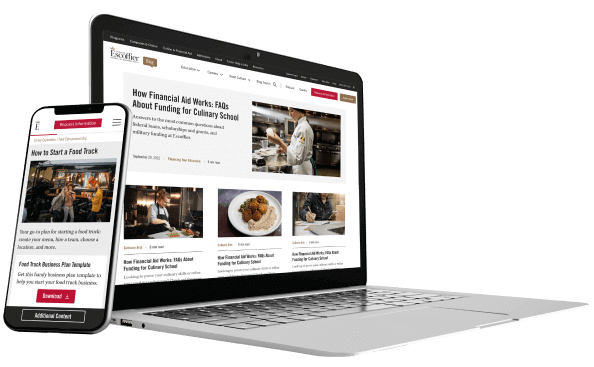Listen to This Article:
Perhaps you have an unrelenting desire to share your flaky chocolate croissants with the world, or you feel called to assemble nutrient-dense meals for business professionals. Whatever your passion might be, starting a food business from home could be the perfect arrangement.
Think about it—you might cut down on operating expenses by not needing to rent a commercial space. Plus, a home-based food business might allow flexibility if you have other life commitments. If this sounds like the path for you, keep reading to discover how you can start a food business from home.
Who Is a Home-Based Food Business Right For?
Running a food business requires navigating food laws, tackling marketing and sales, and managing all other aspects of a small business.
A home-based food business could be a good fit for you if you:
- Have room in your kitchen for production and storage
- Want a lower-cost business model and don’t want to rent commercial kitchen space
- Enjoy independent work and managing all aspects of a business
- Can follow food safety and compliance regulations
- Are willing to take the steps to find customers and market your business
However, this type of business may not be the best fit for you if you prefer working with others, aren’t ready to take on business-related tasks, or want to scale quickly. Home-based food businesses can experience slower growth due to production limits in some states’ laws. If these challenges sound manageable, then starting a food business from your house could be a good way to begin turning your passion into a career.
1. Pick Your Home-Based Food Business Idea
Choosing the right business idea is the first step in turning your passion into profitability. The key is finding the right niche that meets your skills, interest, and market demand. You might dream about selling baked goods from home, bottling your homemade barbecue sauce, or helping busy families enjoy a well-balanced dinner with a meal prep service.
Here are a few ideas:
Sell Distinct Consumer Packaged Goods
Selling homemade baked goods is a classic example of a home-based food business. But you can also think outside the box and consider other shelf-stable consumer packaged goods that might be highly sought after and help you stand out from the crowd.
This could look like bottling homemade kimchi or pickled vegetables. Maybe you can sell grandma’s spicy marinara sauce in mason jars…or even dried soup mixes with produce straight from your home garden. These products can be appealing to health-conscious consumers and are often sold at farmers’ markets, online, or at local grocers.
Start Professionally Meal Prepping
With so many 9-5 multitasking workers, parents, and entrepreneurs, offering meal-prepping services could greatly improve someone’s daily life. Plus, meal-prepping is one of the fastest-growing industries in the U.S.—with services like meal kit delivery expected to hit more than $20 billion in revenue by 2030.
If this is a viable option for you, think about how to serve your target demographic. Consider whether you want to focus on a specific style of eating, such as keto-friendly meals, or target a market like busy families. You’ll also need to decide if you want to deliver, ship, or offer pick-up meals.
Meal prep businesses may require different licensing than selling packaged food, especially if working with meat or dairy products. Check for state and local requirements.
Begin Home-Based Catering
If you enjoy cooking for a crowd, a home-based catering business can be a great way to get started by delivering completed dishes to events. You can begin with small gatherings, corporate lunches, or boutique events and scale up from there.
Like meal prepping, having a strong, well-planned menu that highlights your strengths, such as farm-to-table fare or plant-based catering is key. Keep in mind that some states require catering businesses to operate out of a licensed commercial kitchen, so check with local health regulations before getting started.
Teach Virtual Cooking Classes
The online cooking classes market is expected to reach $485 million by 2027. With many businesses offering remote services and more consumers seeking out virtual experiences, teaching online cooking classes could be an idea worth exploring.
Whether you specialize in northern Italian cuisine, French pastries, or plant-based meals, you can teach classes via Zoom or sell pre-recorded courses online.
2. Research Food Laws and Licensing Requirements
Food laws can vary depending on the idea you decide to execute. First, it’s important to consult with your local food and business regulatory agencies to get the lay of the land. Because you’re operating out of your home, you won’t need to register with the FDA, but you will need to check your state and county’s local laws.
Understand Cottage Food Laws
Governed by your local department of health, cottage food laws usually dictate exactly what you can sell, labeling restrictions, product volume, and more.
In most states, you’ll have to get approved to sell from home, and the following might be evaluated:
- Kitchen inspection
- Zoning permits and business licenses
- Pets may not be permitted, depending on the state
Cottage Food laws also limit the gross sales you can have as a home-based food business. For example, Colorado restricts your net revenue to $10,000 per product, while Texas has a limit of $50,000 gross sales per year. You can learn more about Cottage Law and any requirements or restrictions through the state health department.
Obtain Proper Business Licenses
Again, depending on your state and county, you will usually have to obtain the appropriate licenses and permits to begin operating from home. This is an essential step to potentially mitigate any legal disputes or penalties down the road. Registering your business also allows the government to collect taxes from your business.** You can start obtaining these licenses by browsing the U.S. Small Business Administration site.
**Note: As Auguste Escoffier School of Culinary Arts is based in the United States, the information provided here is specific to American students. International students should consult the tax codes of their respective countries. Nothing in this article is intended to be professional tax advice. Always consult a tax advisor regarding your specific situation.
3. Create a Business Plan
It’s time to flesh out the nuts and bolts of your home-based food business. A solid business plan helps you create a foundation for any successful business. It can help you create a roadmap for your business by clarifying the details of your business, including your vision and goals. Whether you’re selling packaged food, catering events, teaching cooking classes, or some other home-based version of a food business, a structured plan can help you get started on the right foot.
Define Your Business Goals and Target Market
It can be tempting to jump right into marketing your business, but first, you want to get clear on why you’re running the business, who you’re serving, and what your goals are. Ask yourself the following questions:
- What do you want to accomplish with your home-based food business? Do you just want to supplement your income? Are you trying to do this full-time career? Are you testing the market for a future restaurant?
- Who is your ideal customer? You may have already determined this in step #1, but if not, this is the time to figure it out. Are they busy professionals looking for simple meal solutions? Parents looking for organic baby food? Or food lovers eager to develop new cooking skills?
- What problem are you solving for your customers? Are you helping busy professionals eat healthier? Offering allergy-friendly baked goods that are hard to find elsewhere? Creating beautifully decorated, customized cookies? Getting clear on who your customer base is can help you market your business.
Defining your goals and who your customers are early on can help guide the rest of your business planning process from branding to pricing.

It’s important to take time to get clear about your business goals and how to reach them.
Choose a Memorable Brand Identity
Your brand is more than just a business name and logo. It’s part of the experience and feeling that you create for your customers. A strong brand can help attract customers and earn their trust.
- Brand Name: It’s always a good idea to make your brand name sweet, short, and punchy, so it’s easy to remember and reference for word-of-mouth marketing. It should reflect your overall brand essence and personality. Also when it’s time to come up with social media handles for Facebook and Instagram, a name that’s brief is ideal.
- Color Palette: Choosing the right colors for your brand can activate an emotional connection with customers. Plan to select two or three colors that reflect your brand’s personality traits (i.e., modern, loud, playful, etc.). Once you solidify your color palette, use these for your branding across the board.
- Customer Experience: How do you want your customers to feel when they buy your product? This will impact your packaging, customer service, and communication.
Conduct Your Financial Due Diligence
It’s important to anticipate the costs involved in any business. A home-based business may cost less than starting a restaurant, but it can still be expensive. Without accounting for hiring staff or renting a commercial space, you might need to initially cover costs of ingredients, equipment, packaging, website/branding, and marketing. Also remember that if you’re building a business from home, you can claim some of your housing and utility costs when filing for taxes.

Food entrepreneur calculating food startup costs for latest catering venture.
When it comes to forecasting costs accurately, students enrolled in Escoffier’s Food Entrepreneurship program dive into the pivotal food business fundamentals, which cover purchasing and cost control. The program then advances from the fundamentals of culinary math, operations, inventory, portion control, ingredient conversions, and recipe costing.
**Note: As Auguste Escoffier School of Culinary Arts is based in the United States, the information provided here is specific to American students. International students should consult the tax codes of their respective countries. Nothing in this article is intended to be professional tax advice. Always consult a tax advisor regarding your specific situation.
Plan Your Pricing and Revenue Model
Proper pricing is crucial for the profitability of your business. Consider the following when setting your prices:
- Ingredient and packaging costs
- Labor and time required per batch/order
- Competitor pricing and industry standards
- Profit margin goals
Based on the type of food business you choose to start, you may also need to consider bulk purchasing costs and shipping fees. For meal prep services and catering, don’t forget about delivery fees and portion pricing.
Establish an Online Presence
A well-designed website and social media presence can help establish credibility and attract new customers.
In the beginning, it might be best to use a simple yet customizable template on Squarespace or Wix to get you started. Try to include powerful call-to-actions, crisp imagery, legible fonts, and customer testimonials if you have them.
You may also want to choose a social media platform like Instagram or Facebook to showcase your products and behind-the-scenes content and engage with potential customers. You don’t need to be on all of the social media platforms. Choose one where your customer base spends their time and focus on that to start.
Your business plan doesn’t need to be elaborate or complex to help you navigate starting and growing a sustainable business. Once you’ve outlined your vision, brand, pricing, and marketing, you will be on your way to launching your home-based food business.
4. Purchase Equipment & Set Up Your Home Workspace
With your business plan in place, you’re ready to start setting up your kitchen for efficiency and compliance. A well-organized workspace can help streamline your production, maintain food safety, and help you grow your business.
Setting Up Your Kitchen
Your kitchen setup will vary based on the type of food business you’re running. A home bakery may need stand mixers and cooling racks, while a meal prep service may need vacuum sealers and extra freezer space. Look for ways to keep your business ingredients separate from your personal food and supplies. Arrange your kitchen so it will be functional, organized, and compliant with food safety regulations. And don’t forget to track your business expenses as you go because they may qualify as tax deductions.
**Note: As Auguste Escoffier School of Culinary Arts is based in the United States, the information provided here is specific to American students. International students should consult the tax codes of their respective countries. Nothing in this article is intended to be professional tax advice. Always consult a tax advisor regarding your specific situation.
Additional Equipment Checklist
- Extra refrigerator
- Blenders
- Mixers
- Knife kit
- Storage containers
- Various cutting boards
- Induction cooktop
- Venting for major appliances
- Microwave ovens
Maintaining Food Safety & Compliance
It’s essential to follow food handling and sanitation best practices. Based on your state, you may be required to keep separate prep areas, designated storage for ingredients, and have additional permits based on what you’re making.
Temperature control is an important factor to consider. Having extra refrigeration or freezer space can help maintain freshness and prevent food from spoiling. Proper storage of dry goods, utensils, and packaging materials is also necessary to help keep your workspace sanitary.
Planning for Growth
As your food business grows, you may need additional equipment. For example, you may be able to start with a standard home kitchen setup but later need to rent a commercial kitchen space to accommodate your growing demand. Planning ahead can help make these changes smoother for you and your business.
Setting up an efficient home workspace is an important key to building a successful food business. With the right setup and equipment, you will be ready to produce high-quality products while meeting safety regulations.
5. Reach Your Customers and Gain Exposure
While word-of-mouth is one of the best forms of marketing, you don’t want it to be your only one. Combining efforts to reach and attract customers through in-person connection, digital marketing, and customer engagement can help you expand your business.
You can gain visibility in your local market by setting up at farmers’ markets and pop-up events, where you can meet potential customers face-to-face. Collaborating with other small businesses like coffee shops or fitness studios can also help you expand your reach.
A strong email marketing strategy can help you stay connected with customers and keep your business top of mind. You can send them exclusive discounts, announce new products or services, and showcase seasonal specials.
Customer reviews can also have a big impact on your credibility. When you’re first starting, you might lean on your family and friends to spread the word by leaving authentic online reviews or sharing your business on social media. A strong foundation of 5-star reviews might help you reach new customers, bolster consumer loyalty, and ignite more word-of-mouth marketing. This is more effective than you might think.
According to WebFX, 92% of consumers trust recommendations over a company’s messaging, so collecting positive feedback can go a long way. However, be sure that you’re following platform guidelines and not compensating people for their reviews.
Finally, don’t overlook packaging as a marketing tool. Adding your social media handles to product labels can make it easier for customers to help promote your company.

Entrepreneur posting behind-the-scenes photos of the business.
If you’re interested in learning more to help market your business, consider Escoffier’s Food Entrepreneurship program, which includes hospitality marketing. You can unpack how to influence consumers through applied marketing strategies. With the right mix of in-person and digital marketing efforts, you can find new customers and turn them into loyal return customers over time.
Dive into How To Start a Food Business From Home
If you have a clear plan in place for your home-based food startup idea and cover your bases from a legal standpoint, you can start selling your products and services in no time. However, if you’re looking to take a deeper dive into each part of this process, Escoffier’s Food Entrepreneurship program might be for you!
In this setting, you can explore the applied marketing concepts, business planning methods, and culinary foundations which could prepare you to launch a business. If you’re ready to kick your concept into high gear, contact us today to discover more about our programs.
ENJOYED THIS FOOD ENTREPRENEURSHIP ARTICLE? TRY THESE ONES NEXT:
- How to Start Your Own Food Truck
- How to Earn a Culinary Degree from Home
- 7 Side Hustles Great Cooks Can Start for Extra Cash
*Information may not reflect every student’s experience. Results and outcomes may be based on several factors, such as geographical region or previous experience.
**As Auguste Escoffier School of Culinary Arts is based in the United States, the information provided here is specific to American students. International students should consult the tax codes of their respective countries. Nothing in this article is intended to be professional tax advice. Always consult a tax advisor regarding your specific situation.


